Ṭhekā – ठेका
Quick Definition: The base composition for a particular tal; used to show the form of a tal, and to keep time in accompaniment.
Literal Meaning: support; platform on which something rests
Theka examples:
Kaharawa Theka (8-beat cycle, light-classical)

Played for 8 cycles:
Tintal Theka (16-beat cycle)
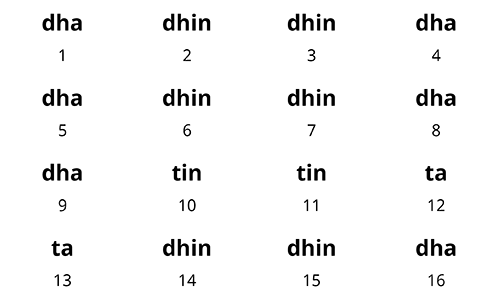
Played for 4 cycles:
Jhaptal Theka (10-beat cycle)

Played for 4 cycles:
Ektal Theka (12-beat cycle)
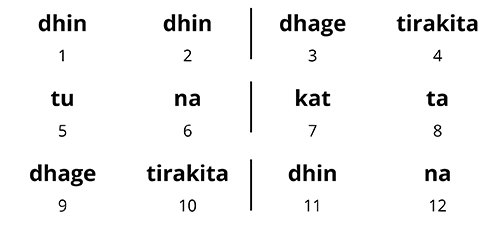
Played for 4 cycles:
See the Tals and Thekas section for more information about these and other thekas.
Introduction to Theka
If you want to follow classical Indian tabla in performance, the first thing you should learn about is tal.
The second thing you should learn about is theka.
A theka is the base composition for a particular tal, and you will hear it more than any other kind of tabla composition.
Most often, you will hear theka in accompaniment (sitar with tabla, vocal with tabla, etc.). You will also hear it in tabla solo, though much less.
Here is a short clip of sitar accompaniment using the tintal theka shown above (Nikhil Banerjee with Swapan Chaudhuri on tabla):
In accompaniment, the tabla player will play the theka most of the time, while giving shorter solos throughout the performance.
In tabla solo, it is the reverse: the tabla player will solo most of the time in a variety of forms, while returning to the theka in between.
The Theka Keeps Time
The theka’s primary role in the music is to keep time. “Keeping time” means both keeping a steady matra (beat), and showing the form of the tal.
In other words, the theka keeps the music grounded in the tal. In accompaniment especially, the theka gives form and vitality to the cycle beneath, while the main solist is free to create on top.
Yet despite how common the theka is, it can be difficult to follow for new listeners. Even if you are familiar with a particular theka, it is still easy to get lost while listening to a performance.
This could be due to a number of reasons. But I suspect it’s because most listeners don’t understand how thekas keep time.
The rest of this section will give an overview of how thekas do their job, and why they are so unusual in the world of drumming.
The theka is a composition, not a rhythm
One of the first things to understand is that a theka is a composition, and not essentially a rhythm.
This doesn’t mean thekas are never rhythmic. Light-classical thekas are clearly rhythmic, and some classical thekas at medium or fast tempos may feel rhythmic when you know them well.
But most of the time, classical thekas are not strongly rhythmic, repetitive, or groove-based—which is one of the reasons why it’s so easy to get lost.
As mentioned above, a theka is composed to keep time. And they do this by keeping a steady matra (beat), and showing the structure of the tal.
We’ll look at both of these aspects below.
The theka keeps the rhythm in accompaniment
One of the ways that the theka keeps time is to keep the rhythm. Again, "rhythm" here does not mean a steady, repetitive groove. It means keeping the steady pulse of the matra (beat). And how it does this can vary greatly throughout a performance.
At slower and medium tempos, thekas are almost never performed exactly as the standard thekas given above. They will be performed with all kinds of fills and embellishments.
If you are not familiar with tabla phrasing, this can make the theka hard to follow, and the rhythm less clear.
At faster speeds, however, the theka is played more straight, with fewer fills and embellishments, making it easier to follow.
Tintal Theka: Slow and Fast Speeds Compared
Here again is the standard tintal theka:

Now listen to two versions of this theka below. The first is in vilambit tempo (slow), with typical fills and embellishments used in accompaniment. And the second is in drut tempo (fast), performed more straight with almost no embellishments.
Tintal theka with embellishments in vilambit (slow) tempo (2 cycles):
Tintal theka in drut (fast) tempo (begins in a slow drut for 2 cycles, then doubles into fast drut for 8 cycles):
The slower vilambit theka does not create a steady rhythm for most listeners. You may hear the pulse of the matra (beat), but there is not a clear rhythm that you can easily catch.
The faster drut theka, on the other hand, has a much clearer rhythm and is easier to follow (though new listeners may still struggle to know where they are in the cycle).
Listen now to two examples of the tintal theka in performance:
Tintal Vilambit (slow) – Sarod with Tabla (Ali Akbar Khan-Mahapurush Misra) :
Tintal Drut (fast) – Sitar with Tabla (Ravi Shankar-Alla Rakha):
Even if you are a new listener, you can hear that the way the theka relates to the beat in each example is very different.
The theka shows the structure of a tal
The second way the theka keeps time is to show the tal’s structure. The particular bols (strokes) of a theka can show a tal’s structure in two related ways:
- Show the vibhags (divisions) of the tal
- Show the tali-khali (stessed-unstressed) pattern of the tal
However, not all thekas show the structure of the tal as clearly as others. Usually, this is because the tali-khali bols of the theka (open and closed bass strokes) do not correspond to the tali-khali pattern of the tal.
For performers, this is not a problem because they know the thekas by heart. But for learners this can be confusing.
Below are thekas for three different tals which all reflect the structure of the tal in different ways.
Jhaptal Theka (clearly shows the tal)
For a very clear correspondence between tal and theka, we can look at jhaptal, a cycle of 10 matras. This tal has a vibhag structure of 2–3–2–3 with a stress pattern of thali-thali-khali-thali:
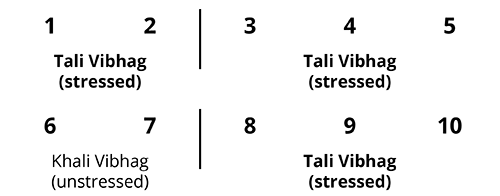
The jhaptal theka below clearly shows this structure in its bols. Notice that the tali and khali bols of the theka clearly correspond to the tali and khali vibhags of the tal (strokes with an open baya are in bold):

Jhaptal Theka Demonstration:
Tintal Theka (shows the tal, but less clearly)
The tintal theka also shows the structure of the tal beneath, but not as precisely. Tintal, a cycle of 16 matras, has a vibhag structure of 4–4–4–4 (tali-tali-khali-tali):
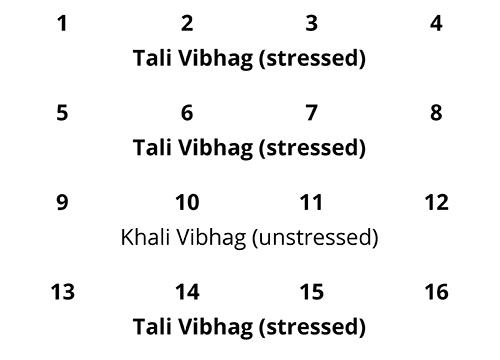
Notice that the khali vibhag (unstressed) includes matras 9-12. But the tintal theka’s khali section is from matras 10–13:
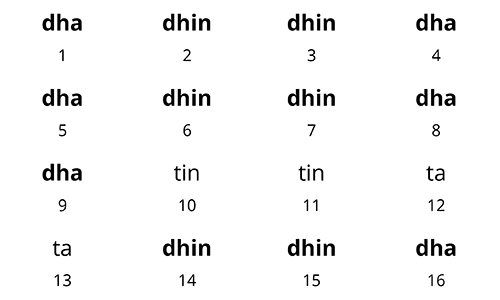
This is a very subtle, but significant, difference.
Tintal Theka Demonstration:
The beginning of a khali section gets a wave of the hand to indicate that it is "empty" of stress. And yet the tintal theka has a stressed bol (dha) at the beginning of its khali section (matra 9). Conversely, the beginning of the third tali section (matra 13) has a khali bol.
Ektal Theka (does not clearly show the tal)
In ektal (12-matra cycle), the theka does not show the structure of the tal very clearly at all.
Ektal has a vibhag structure of 2–2–2–2–2–2 (tali-khali-tali-khali-tali-tali):
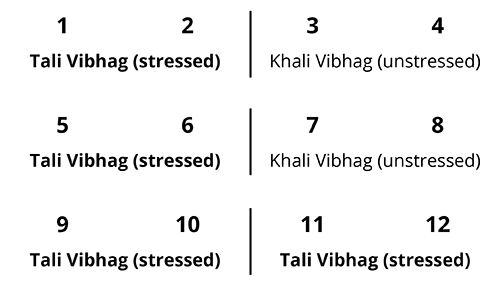
But the bols of the ektal theka do not correspond regularly to this structure (tali bols are in bold):

Notice that the second vibhag (khali) begins with the tali bols dhage, and the third vibhag (tali) has khali bols tu na.
Ektal Theka Demonstration:
(See the Tals and Thekas Section for more information on these and other tals.)
And so there is some irregularity in how the various thekas show the form of the tal. For soloists, this is not a problem. They will still know where they are in the tal by listening to the bols of the theka.
Similarly, listeners should learn the structure of the tal first, then memorize the bols for the standard theka, and then listen for particular bols in performance.
Learning to Follow the Theka
Learning to follow the theka at different speeds, and in a variety of performance contexts, can take time.
When I first began studying the tabla, it took some weeks before I could begin to follow the tintal theka in performance. I already knew the theka bols and was practicing them everyday. But still it took time.
So listeners will need to make some effort. You should first learn about tal and learn to keep time. Then learn at least the bols of the standard thekas.
If you are new to the tabla, you might start with the light-classical thekas of dadra and kaharawa, and then listen to light-classical performances. These are easier to follow and will give you a good feel for tabla in accompaniment.
But then you should focus on tintal. After learning the standard theka, learn to speak some theka variations in a variety of tempos. This will help you follow the theka in performance.
Then, of course, you need to do lots more listening.
See the Listener’s Guide for more guidance.
References
Misra, Chhote Lal. Playing Techniques of Tabla – Banaras Gharana. New Delhi: Kanishka Publishers, 2007.
—. Tal Prabandh. New Delhi: Kanishka Publishers, 2006. (Hindi)
Music Sources
(Note: Audio excerpts are presented for educational purposes only under the Fair Use doctrine.)
Banerjee, Nikhil & Chaudhuri, Swapan. Sohini. On Nikhil Banerjee. Calcutta: EMI. (1972). Listen online
Khan, Ali Akbar & Misra, Mahapurush. Rag Chandranandan. On Signature Series/Vol. 1. Ammp Records. (1990) Listen online
Shankar, Ravi & Khan, Alla Rakha. Dhun-Drut Tintal. On Ragas Varanasi. Ex Works. (1998)